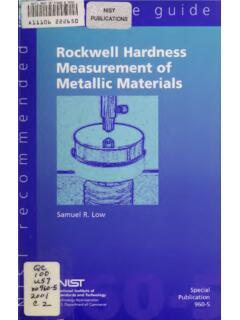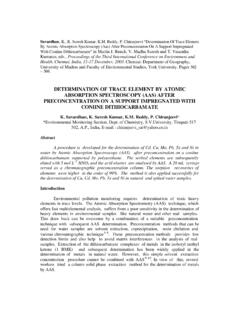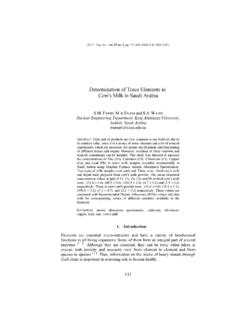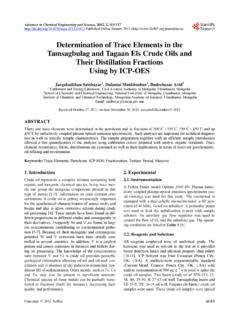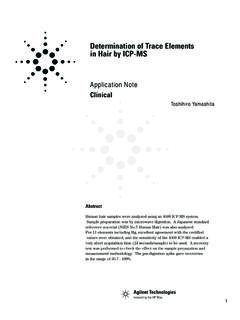Transcription of Determination of trace elements in ruby laser …
1 JOURNAL O F RESEARCH o f the Nationol Bureau of Standards-A. Physics and Chemistry Vol. 75A, , September-October 1971 j Determination of trace elements in Ruby laser Crystals by Neutron Activation Analysis Barbara A. Thompson and Eric C. Miller* Institute for Materials Research, National Bureau of Standards, Washington, 20234 (March 30, 1971) M e th od s a re describe d by whic h concentra ti o n le ve ls have been d e termine d fo r "IJ tl) te n differe nt trace e lements and uppe r limits establis h e d fo r over 40 additio n a l e le m ents at parts pe r million le ve l or below in ruby crystals us in g n eutron activa ti o n analysis . This informatio n is require d to d e te r mine effect. of trace e le m e nt le ve ls o n laser p erforma nce.
2 With conventio nal a n a lytical m ethods diffIculties arise because of both the re fractory and in sulating of the Because the c ry s ta ls cannot. be readily dissolved, the ac ti vatio n a na lysis was carrie d out nondestruc li vely, irradiating the samples with hi g hl y therma lize d neutro n s to minimize formatio n o f 2<1 Na a nd 27 Mg from (Il, a) and (II., p) reacti o n s o n th e A I, O " matrix, and us in g a 47 cm " Ce(Li) detecto r. Key words: A ctivation a na lysis; AI,03; interfering reactio n s; laser ; nondestructive a na lysis; ruby; t race e lements. 1. Introduction In order to d e termine the effect of trace eleme nt concentrations on the performance of ruby laser c rys tals, informa tion is r equired for as m an y ele me nts as possible at th e ppm and ppb levels.
3 This means ob-taining good analytical data on single cry s tals of a-AI20:l containing small amounts (~ % or less) of erZO:l. Because AlzO:l is an excelle nt in s ulator, it is diffic ult to s park and thus presents proble m s for analy-tical me th od s suc h as e mission s pectroscopy and spark source mass s pectrome try whic h require an electrically conducting sample. Various techniques for overcoming this diffic ulty have bee n tried , including sputte ring with gold and mixing ground samples with graphite, but they have met with limited success. Obviously , th e problem of possible introduction of contaminants in either of these procedures is very senous . For neutron activation analysis, however, the ruby crystals are nearly ideal samples.
4 The principal radio-, nuclide formed from the AlzO:l matrix is 28AI which I has a min half-life and thus presents no interfere nce the measurement of trace element activities after a 30 to 60 min decay period. During this time th e short-live d nuclides formed from oxygen will also decay away as will most of the min 27Mg produced by the action 10f fa s t neutrons on aluminum. The only significant matrix activity will be 24Na, also formed from aluminum by fast neutrons. This information is summarize d in table 1. *NSF Summer Fellow; present addrt~ss: \Ves t Virginia Unive rsity, Morgantown. W. Va. 26505. Because of favorable nuclear prope rties muc h attention has been giv e n to th e d e te rmination of trace ele m ents in aluminum m by ne utron ac tivatio n analysis, beginning with the classic work of Albert and co-worke rs (1) and continuing to th e present (2).
5 At ultratrace le vels however , analyses have us ually r equire d c hemical separations and so h ave been utilized less with ALO:! than with Al me tal because of the very r efrac tory nature of th e oxide. We in er, O'Connor, and Rubin (3) have re ported de termining th e Cr dopant in ruby crys tals and Ortega (4) has d e ter-mine d -Er and Ir where Er was added as a dopa nt. Both analyses were carried out using nondestruc tive neutron activation analysis and NaI(Tl) de tectors . With the current availability of hi gh resolution Ge(Li) detectors of good efficiency, it should be possible to determine many elements in the ruby crystals at th e levels required, without chemical separations. This paper describes the procedures by whic h concentra-tion levels were quantitatively dete rmine d for as many as ten different trace elements and uppe r limits estab-lished for over 40 additional elements at th e ppm le vel or below in several different ruby crystals_ TABLE 1.
6 Neutron reactions of aluminum and oxygen Reacti o n "AI ( n, y)28AI "AI (n, p) 27Mg 27 Al (n , a) 24Na 180 (n, y) 190 160 ( n , p) 16N 170 ( n , p) I7N Product half-life min min 15 h 27 s 7 s 4s 429 l FIGURE 1. Ruby crystul os Cllt for (Jllolysis, diameter em. 2. Experimental Detail The ruby boules analyzed had been grown by the Czochralski method and were obtained from com-mercial sources as part of a continuing study of high temperature materials and laser materials (5). Samples for analysis were cut with two parallel sides and had similar cross-sectional areas. This assured a reproduc-ible counting geometry which could be duplicated in the standards. These conditions must be met in order to obtain accurate and precise results. Figure 1 shows a crystal slice which has been c ut into sections for analysis.)
7 If the material could be dissolved readily, the reproducible counting geometry could be achieved with samples of any shape, by dissolving them and making the solution up to a standard volUIlie for counting. How-ever, because of the extreme insolubility of a-AI20;\ this approach was not feasible. 4 XI04 4 XIO' 166 13980 479 187W 320 686 SICr 187W 388 87mSr 511 134 :4CU 552 618 IB7W ( No) IB7W TANK WALL ~ RT -1 WI////I!///;, --RT~-2 :;1Il////I/I! RT -3 -I-RT -4 FIGURE 2. Positions of pneumatic tube terminals in the NBS Reactor. The ruby slices to be analyzed, g in weight, were heat-sealed in me dical-grade polyethylene tubing and irradiated for 1 h in pneumatic tube RT-4 of the National Bureau of Standards Reactor. The thermal neutron flux in this facility is about 1 X 1013n cm-2s -l Figure 2 shows the locations of the four pneumatic tube facilities of the NBS Reactor relative to the reactor core (shaded area).
8 Of the four facilities RT-4 has the highest ratio of thermal to fast neutrons. The use of this facility for the ruby irradiations thus minimizes the production of 15-h 24Na which, as noted above, is formed by the action of fast neutrons on aluminum. A small copper foil flux monitor (1-2 mg) was taped to the outside of each polyethylene capsule to permit normali-zation of small differences in neutron flux or irradiation time from sample to sample. After irradiation the samples were allowed to stand for at least 30 min to reduce the intense activity from 28Al. They were then rinsed in acetone and 1: 1 HN03 to remove surface contamination and transferred to polyethylene snapcap vials for counting. Each sample was counted at several different times using a 47-cm3 Ge(Li) detector and a 2048-channel pulse height analyzer.
9 Figure 3 shows a typical gamma ray spectrum of a crystal containing small amounts of Ba, Sr, W, Cu, Ga, and Mn in addition to the Cr dopant. This I 1369 773 835 847 ENERGY-FIGURE 3. Gamma ray spectrum of irradiated ruby crystal ; 100 min count, d h after irradiation. 430 s pectrum was recorded at about three hours after irradiation. Except fo r th e 139Ba and ol C r photopeaks , th e most inte nse gamma ray is the 1369 keY pe ak of 24Na. To dete rmine whe th e r this was all due t o th e fast neutron re a c tion on th e aluminum in th e matrix, some c r ystals we re irradiate d in both RT- 3 and RT- 4 , with a cooling pe riod of about a month be tween ir-radiations to be sure that all 24Na had decaye d away. As figure 2 indicates, RT-3 terminates closer to th e reacto r core and thus has a s ubs ta ntially hig he r ratio of fa s t to th ermal n eutrons than RT- 4.
10 In both ir-radiations th e "concentration" of s odi u m, in }-tg/ g, was ca lc ulate d by comparison to a s t a ndard of pure , sodium carbonate irradiate d unde r th e same condi tions. If th e 24N a we re be in g produced by th e re a c tion of th ermal neutrons with trace amounts of sodium in th e rubies, th e concentration would be th e same for bo th irradiations. H o we ve r , if th e sodium we re b e in g produced by fast neutro ns fr o m th e Al in th e matrix, its "concentra ti o n" would be highe r in RT- 3 because of th e hi}.!:lw r proportiull of fast neutruns. In this case th e observ e d sodium le ve l could be expecte d to be inversel y pro po rtional to th e cadmium ratio. A s t able 2 shows, th e sodium "concentratio n " does inc rease in RT- 3 relative to RT- 4 and th e inc re ase is very similar to t h e decreases in th e cadmium ra ti os for both gold and coppe r whic h have been d e termine d for these two facilities (6).









